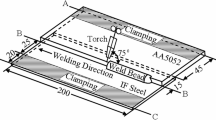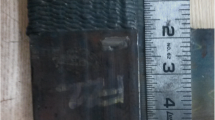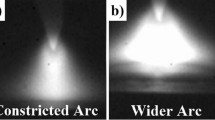Abstract
The thermomechanical distortion and the evolution of an interface layer with intermetallic phases are the two critical challenges for gas metal arc overlap joining of multimaterial sheets. Two novel analytical methods are proposed following mechanistic principles to estimate the thermomechanical distortion and the interface layer thickness. The analytically estimated results are tested rigorously with the corresponding experimentally measured results for gas metal arc joining of aluminium and steel sheets for different process conditions. Both the thermomechanical distortion and the interface layer thickness are influenced predominantly by the wire feed rate and the resulting heat input. The interface layer thickness and the thermal distortion are found to be the minimum for a heat input of 42.4 J/mm corresponding to the lowest wire feed rate of 4 m/min and the highest travel speed of 10 mm/s. The proposed analytical methods can serve as practical easy-to-use design tools for appropriate selection of process variables in gas metal arc overlapped joining of dissimilar sheets to mitigate the joint distortions and restrict excessive growth of the interface layer.












Similar content being viewed by others
Data availability
The raw/processed data required to reproduce these findings cannot be shared due to technical or time limitations.
Abbreviations
- A Al::
-
Cross-sectional area of aluminium sheet and filler wire deposit (mm2)
- A Fe::
-
Cross-sectional area of steel sheet (mm2)
- C Fe::
-
Mole fraction of iron
- C 0Fe::
-
Initial solubility of iron before occurrence of nucleation
- E Al, E Fe::
-
Young’s modulus of aluminium and steel (GPa)
- E eqv::
-
Equivalent Young’s modulus of the assembly (GPa)
- F::
-
Force (N)
- I::
-
Area moment of inertia (mm4)
- I a, V a::
-
Average arc current, average arc voltage (A, V)
- L::
-
Joint length (mm)
- M::
-
Moment (N-mm)
- N A::
-
Avogadro’s constant
- O::
-
Centre of curvature
- Q: :
-
Activation energy (kJ/mol)
- R::
-
Universal gas constant (J/mol-K)
- TS::
-
Travel speed (mm/s)
- T P, T 0, T intf::
-
Peak, ambient and interface temperatures (K)
- WFR::
-
Wire feed rate (m/min)
- T i, T i +1::
-
Temperature at ith and (i + 1)th instants (K)
- X i, X i+1: :
-
Layer thickness at ith and (i + 1)th instants (µm)
- d::
-
Vertical displacement from the horizontal plane (mm)
- f::
-
Atomic vibration frequency
- h 1::
-
Distance of the upper surface of aluminium sheet from the neutral plane: (mm)
- h 2::
-
Distance of bottom surface of steel sheet from the neutral plane (mm)
- k::
-
Boltzmann constant (J/K)
- k a::
-
Average thermal conductivity (W/mm-K)
- k 0::
-
Pre-exponential factor (mm2/s)
- n 1::
-
Number of critical size embryos
- r::
-
Radius of curvature (mm)
- r 1::
-
Distance between temperature monitoring point and arc centre (mm)
- t, t i, t i +1::
-
Time variable, time at ith and (i + 1)th instants (s)
- thAl, thFe::
-
Thickness of aluminium and steel sheets (mm)
- thnu::
-
Layer thickness due to nucleation (µm)
- thintf::
-
Interface layer thickness (µm)
- ΔG*::
-
Critical energy barrier for formation of hemispherical nucleus (J)
- Ω::
-
Pre-exponential factor (/m2)
- α Al, α Fe::
-
Coefficient of thermal expansion (CTE) of aluminium and steel (/K)
- β, η: :
-
Adjustable parameter, process efficiency
- γ a::
-
Average diffusivity (mm2/s)
- ρ Al, ρ Fe, ρ Fe2Al5::
-
Density of aluminium, steel and Fe2Al5 (kg/m3)
- σ Al, σ Fe::
-
Thermal stress on aluminium and steel sheet (MPa)
- ζ, λ::
-
Distance of temperature monitoring point from heat source in travel speed direction and transverse distance from monitoring location (mm)
References
Agudo L, Eyidi D, Schmaranzer CH, Arenholz E, Jank N, Bruckner J et al (2007) Intermetallic FexAly-phases in a steel/Al-alloy fusion weld. J Mater Sci 42:4205–4214. https://doi.org/10.1007/s10853-006-0644-0
Das A, Shome M, Goecke SF, De A (2017) Joining of aluminium alloy and galvanized steel using a controlled gas metal arc process. J Manuf Process 27:179–187. https://doi.org/10.1016/j.jmapro.2017.04.006
Goecke SF, Makwana P, Shome M, De A (2019) Probing joint strength and distortion in gas metal arc lap joining of aluminum and steel sheets. Weld World 63:229–236. https://doi.org/10.1007/s40194-018-0653-z
Das A, Shome M, Das CR, Goecke SF, De A (2015) Joining of galvannealed steel and aluminium alloy using controlled short circuiting gas metal arc welding process. Sci Technol Weld Joi 20:402–408. https://doi.org/10.1179/1362171815Y.0000000032
Das A, Goecke SF, De A (2021) Joining of aluminium alloy and galvanized steel sheets multi material assembly using a gas metal arc based process. Tecnol Metal Mater Min 18:1–7. https://doi.org/10.4322/2176-1523.20212464
Evdokimov A, Doynov N, Ossenbrink R, Obrosov A, Weiß S, Michailov V (2021) Thermomechanical laser welding simulation of dissimilar steel-aluminum overlap joints. Int J Mech Sci 190:106019. https://doi.org/10.1016/j.ijmecsci.2020.106019
Das A, Shome M, Goecke SF, De A (2016) Numerical modelling of gas metal arc joining of aluminium alloy and galvanized steels in lap joint configuration. Sci Technol Weld Joi 21:303–309. https://doi.org/10.1080/13621718.2015.1104206
Das A, De A (2018) Gas metal arc lap joining of aluminium alloys and steel sheets. J Weld Joi 36: 19 – 26. https://doi.org/10.5781/JWJ.2018.36.5.3 (https://e-jwj.org/upload/jwj-36-5-19.pdf)
Goecke SF, Arshad AS, Spiegel EM, De A (2017) Probing current, voltage and metal transfer characteristics in pulsed arc and in conventional and a novel low energy input short arc GMAW. Q J Japan Weld Soc 31:26s–30s. https://doi.org/10.2207/qjjws.31.26s
Makwana P, Shome M, Goecke SF, De A (2018) Fast responsive control of current and voltage waveforms for gas metal arc brazing of thin zinc-coated steel sheets. J Mater Process Tech 254:171–178. https://doi.org/10.1016/j.jmatprotec.2017.11.028
Sun J, Liu X, Tong Y, Deng D (2014) A comparative study on welding temperature fields, residual stress distributions and deformations induced by laser beam welding and CO2 gas arc welding. Mater Design 63:519–530. https://doi.org/10.1016/j.matdes.2014.06.057
Kohandehghan AR, Serajzadeh S, Kokabi H (2010) A study on residual stresses in gas tungsten arc welding of AA5251. Mater Manuf Process 25:1242–1250. https://doi.org/10.1080/10426914.2010.481004
Deng D, Murakawa H (2008) Prediction of welding distortion and residual stress in a thin plate butt-welded joint. Comp Mater Sci 43:353–365. https://doi.org/10.1016/j.commatsci.2007.12.006
Deng D, Zhou Y, Liu X (2013) Experimental and numerical investigations of welding distortion induced by CO2 gas arc welding in thin-plate bead-on joints. Mater Design 52:720–729. https://doi.org/10.1016/j.matdes.2013.06.013
Deng D, Liu X, He J, Liang W (2016) Investigating the influence of external restraint on welding distortion in thin-plate bead-on joint by means of numerical simulation and experiment. Int J Adv Manuf Tech 82:1049–1462. https://doi.org/10.1007/s00170-015-7413-7
Long H, Grey D, Carlier A, Maropoulos PG (2009) Prediction of welding distortion in butt joint of thin plates. Mater Design 30:4126–4135. https://doi.org/10.1016/j.matdes.2009.05.004
Bajpei T, Chelladurai H, Ansari MZ (2016) Mitigation of residual stresses and distortions in thin aluminium alloy GMAW plates using different heat sink models. J Manuf Process 22:199–210. https://doi.org/10.1016/j.jmapro.2016.03.011
Zain-ul-abdein M, Nélias D, Jullien JF, Deloison D (2010) Experimental investigation and finite element simulation of laser beam welding induced residual stresses and distortions in thin sheets of AA 6056–T4. Mater Sci Eng A 527:3025–3039. https://doi.org/10.1016/j.msea.2010.01.054
Zain-ul-abdein M, Nélias D, Jullien JF, Deloison D (2009) Prediction of laser beam welding-induced distortions and residual stresses by numerical simulation for aeronautic application. J Mater Process Tech 209:2907–2917. https://doi.org/10.1016/j.jmatprotec.2008.06.051
Huang H, Wang J, Li L, Ma N (2016) Prediction of laser welding induced deformation in thin sheets by efficient numerical modelling. J Mater Process Tech 227:117–128. https://doi.org/10.1016/j.jmatprotec.2015.08.002
Michaleris P, DeBiccari A (1997) Prediction of welding distortion. Weld Res Supp 76:172s–181s
Schenk T, Richardson IM, Kraska M, Ohnimus S (2009) Modeling buckling distortion of DP600 overlap joints due to gas metal arc welding and the influence of the mesh density. Comp Mater Sci 46:977–986. https://doi.org/10.1016/j.commatsci.2009.05.003
Madhavan S, Kamaraj M, Vijayaraghavan L, Rao KS (2017) Microstructure and mechanical properties of aluminium/steel dissimilar weldments: effect of heat input. Mater Sci Tech 33:200–209. https://doi.org/10.1080/02670836.2016.1176716
Dong H, Hu W, Duan Y, Wang X, Dong C (2012) Dissimilar metal joining of aluminum alloy to galvanized steel with Al-Si, Al-Cu, Al-Si-Cu and Zn-Al filler wires. J Mater Process Tech 212:458–464. https://doi.org/10.1016/j.jmatprotec.2011.10.009
He H, Yang C, Lin S, Fan C, Chen Z, Chen Z (2014) Flux modification for AC-TIG braze welding of aluminium to stainless steel. Sci Technol Weld Joi 19:527–533. https://doi.org/10.1179/1362171814Y.0000000220
Sierra G, Peyre P, Beaume FD, Stuart D, Fras G (2008) Galvanised steel to aluminum joining by laser and GTAW processes. Mater Charact 59:1705–1715. https://doi.org/10.1016/j.matchar.2008.03.016
Windmann M, Rottger A, Kugler H, Theisen W, Vollertsen F (2015) Laser beam welding of aluminum to Al-base coated high-strength steel 22MnB5. J Mater Process Tech 217:88–95. https://doi.org/10.1016/j.jmatprotec.2014.10.026
Su Y, Hua X, Wu Y (2014) Influence in alloy elements on microstructure and mechanical property of aluminum–steel lap joint made by gas metal arc welding. J Mater Process Tech 214:750–755. https://doi.org/10.1016/j.jmatprotec.2013.11.022
Murakami T, Nakata K, Tong H, Ushio M (2003) Dissimilar metal joining of aluminum to steel by MIG arc brazing using flux cored wire. ISIJ Int 43:1596–1602. https://doi.org/10.2355/isijinternational.43.1596
Peyre P, Sierra G, Beaume FD, Stuart D, Fras G (2007) Generation of aluminium–steel joints with laser-induced reactive wetting. Mater Sci Eng A 444:327–338. https://doi.org/10.1016/j.msea.2006.09.111
Bang HS, Hong SM, Das A, Bang HS (2020) A prediction of Fe-Al IMC layer thickness in TIG-assisted hybrid friction stir welded Al/steel dissimilar joints by numerical analysis. Int J Adv Manuf Tech 106:765–778. https://doi.org/10.1007/s00170-019-04560-x
Grong O (1997) Metallurgical modelling of welding. In: Bhadeshia H K D H (ed) The Institute of Materials, 2nd edn. London
Gray T, Camilleri D, McPherson N (2014) Control of welding distortion in thin-plate fabrication: design support exploiting computational simulation. Woodhead Publishing, United Kingdom. https://www.sciencedirect.com/book/9780857090478/control-of-welding-distortion-in-thin-plate-fabrication#book-info
Mandal GK, Balasubramaniam R, Mehrotra SP (2009) Theoretical investigation of the interfacial reactions during hot-dip galvanizing of steel. Metall Mater Trans A 40A:637–645. https://doi.org/10.1007/s11661-008-9748-2
Grujicic M, Snipes JS, Ramaswami S, Galgalikar R, Yen CF, Cheeseman BA (2019) Computational analysis of the intermetallic formation during the dissimilar metal aluminum-to-steel friction stir welding process. Proc IMechE Part L: J Mat 233:1080–1100. https://doi.org/10.1177/1464420716673670
Tang NY (1995) Modeling Al enrichment in galvanized coatings. Metall Mater Trans A 26A:1699–1704. https://doi.org/10.1007/BF02670756
Springer H, Kostka A, Payton EJ, Raabe D, Kaysser-Pyzalla A, Eggeler G (2011) On the formation and growth of intermetallic phases during interdiffusion between low-carbon steel and aluminum alloys. Acta Mater 59:1586–1600. https://doi.org/10.1016/j.actamat.2010.11.023
Cheng WJ, Wang CJ (2011) Effect of silicon on the formation of intermetallic phases in aluminide coating on mild steel. Intermetallics 19:1455–1460. https://doi.org/10.1016/j.intermet.2011.05.013
Maitra T, Gupta SP (2002) Intermetallic compound formation in Fe–Al–Si ternary system: Part II. Mater Charact 49:293–311. https://doi.org/10.1016/S1044-5803(03)00005-6
Rathod MJ, Kutsuna M (2004) Joining of aluminum alloy 5052 and low-carbon steel by laser roll welding. Weld J 83:16s–26s
Potesser M, Schoeberl T, Antrekowitsch H, Bruckner J (2006) The characterization of the intermetallic Fe-Al layer of steel-aluminum welding. In: Howard SM, Stephens RL, Newman CJ, Hwang JYJ, Gokhale AM, Chen TT, Battle TP, Free ML, Davis BR, Harris CL, Henein H, Anyalebechi PN, Powell AC, Krumdick GK, Belt CK (Eds.), Proceedings of EPD Congress - The Minerals, Metals & Materials Society, Texas, 167 – 176
Author information
Authors and Affiliations
Contributions
A. Das: analytical methodology development, microstructural characterization, validation, experimentation, writing—original draft. P. K. Chaurasia: experimentation, analytical methodology development, validation, writing—original draft. G. K. Mandal: analytical methodology development, conceptualization, writing—review and editing. S. F. Goecke: conceptualization, writing—review and editing. A. De: conceptualization, writing—review and editing.
Corresponding author
Ethics declarations
Conflict of interest
The authors declare no competing interests.
Additional information
Publisher's note
Springer Nature remains neutral with regard to jurisdictional claims in published maps and institutional affiliations.
Recommended for publication by Commission II - Arc Welding and Filler Metals
Appendices
Appendix 1
Estimation of peak temperature at the thermocouple monitoring location and the joint interface
Rosenthal’s pseudo-steady state moving heat surface solution for thin-plate geometry is used to calculate the temperature fields in dissimilar assembly of aluminium and steel sheets as
where TP and T0 are peak and ambient temperatures, respectively. Va and Ia are average arc voltage and current, η depicts the process efficiency ~ 0.75, TS is the travel speed and \({K}_{0}\left(\mathrm{TS}\frac{{r}_{1}}{2{\gamma }_{\mathrm{a}}}\right)\) represents the modified Bessel function of the second kind with order zero. ka is the average thermal conductivity of aluminium and steel, and γa is the average diffusivity of aluminium and steel. r1 is the distance between temperature measuring point and the arc centre, \({r}_{1}=\sqrt{{\upzeta }^{2}+{\uplambda }^{2}}\).
ζ depicts the distance between the monitoring location and the arc centre along the direction of the travel speed and is considered (100-vt), where t is the time interval, λ is the transverse distance from the monitoring location and 100 indicates half-length of the joint. thT signifies sheet thickness, the values of thT are taken as 1.8 mm and 1 mm in estimating temperature at the thermocouple monitoring location and at the joint interface, respectively.
A sample estimation of peak temperature at a thermocouple measuring location for TS of 10 mm/s and WFR of 5 m/min is shown in Table 6. The peak temperature is estimated 3 mm away from thermocouple location in transverse direction due to the limitation of Rosenthal’s solution, which estimates exaggerate values of temperature exactly under the arc. For a given process condition, TP is estimated at several values of ζ under different time interval along joining direction and represented as a thermal cycle in Fig. 4.
Appendix 2
Estimation of thermomechanical distortion
As per compatibility norm, Fig. 3(b), final contraction of the steel sheet will be equal to the final contraction of the aluminium sheet, that can be expressed as
The resistance against contraction will develop a pair of equal and opposite forces on the transverse cross-sections of both sheets. The force equilibrium can be expressed as
Equating Eqs. (B.2) and (B.3) will provide Eq. (1). The equivalent Young’s modulus in Eq. (3) is estimated as
where ρFe and ρAl are density of steel and aluminium sheets, respectively.
The position of the neutral plane is located considering concept of pure bending with resultant axial force acting along the cross-section is zero; therefore,
where r is the radius of curvature and y is the distance from the neutral plane. The first integral in Eq. (2.6) is evaluated over the cross-sectional area of aluminium sheet and filler deposit, and the second is evaluated over the area of the steel sheet. Since the radius of curvature is constant at any given cross-section; therefore, it can be eliminated and the equation to locate neutral plane is
The integral of the above equation depicts the first moment of aluminium and steel sheets cross-section of the overlapped assembly with respect to the neutral plane.
The longitudinal distortion at any position is deduced from the pure bending analysis of the distorted bi-metallic assembly as shown in Fig. 3(c). An independent point P is chosen at the neutral plane M1N1 which is always at the distance of r from the origin. Therefore, the vertical location of point P can be expressed as
Since the length SP and h1 are very small as compare to the radius of curvature of the joint assembly, the arc SV can be considered a tangent at point V indicating the ∆PVS as a right-angle triangle. Therefore, a comparison of ∆OQ1P and ∆PVS expresses
The distance PG and GH are given as
Eventually, the distortion of any point on the top of the assembly along longitudinal axis A′A′ can be estimated by adding Eqs. (2.9) to (2.11).
Rights and permissions
Springer Nature or its licensor (e.g. a society or other partner) holds exclusive rights to this article under a publishing agreement with the author(s) or other rightsholder(s); author self-archiving of the accepted manuscript version of this article is solely governed by the terms of such publishing agreement and applicable law.
About this article
Cite this article
Das, A., Chaurasia, P.K., Mandal, G.K. et al. Analytical estimation of thermomechanical distortion and interface layer thickness for gas metal arc lap joining of dissimilar sheets. Weld World 67, 33–49 (2023). https://doi.org/10.1007/s40194-022-01426-x
Received:
Accepted:
Published:
Issue Date:
DOI: https://doi.org/10.1007/s40194-022-01426-x




